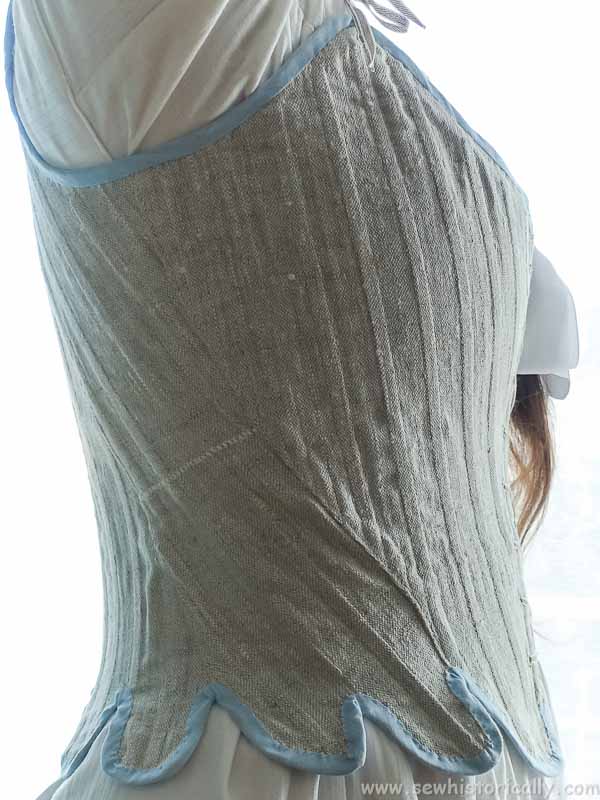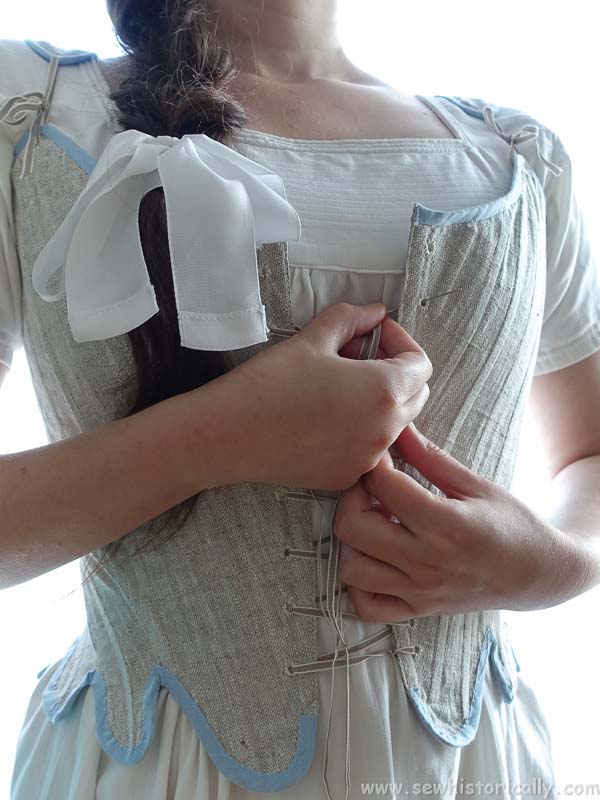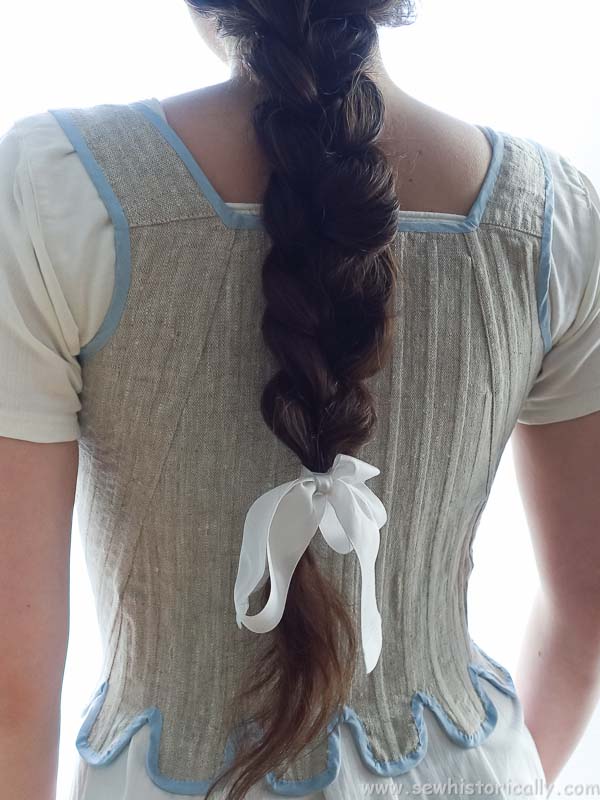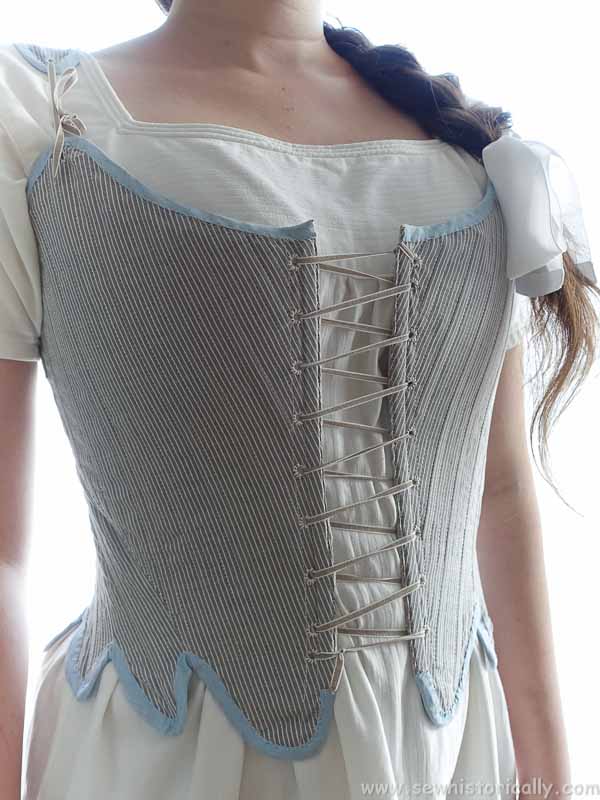These 18th century linen stays were an impromptu sewing project! After seeing modern versions of 18th century stays worn as top on instagram, and since I had linen fabric scraps in my stash, I spontaneously decided to make 18th century linen stays!
So on the same day I searched for antique 18th century stays for inspiration. And I made the pattern in the night! 😀 This is one of my quickest historical sewing projects so far: Usually the research takes much longer. But the 18th century isn’t my favorite historical era, so I don’t mind if these stays aren’t 100% historically accurate! 😉
Related: Historical Nighttime Hair Routine
Are The 18th Linen Stays Historically Accurate?
My 18th century stays are partly historically accurate and partly not: The pattern, the linen fabric, the fabric piecing, the spiral lacing and the hand-sewn eyelets are all historically accurate. But there are also some things that are not historically accurate: I sewed the boning channels on my sewing machine and I used the welt seam method which wasn’t used in the 18th century. I also had to use synthetic whalebone because whalebone isn’t available anymore and I used bias binding instead of straight-grain binding. And the pinstripe cotton fabric probably isn’t historically accurate either! 😉

Inspired By The Dirndl
My 18th century linen stays are actually inspired by rural stays and Dirndl bodices! 😀 The following 18th century painting were my main inspirations: ca. 1750s drawing of a young German woman, drawing of a German maid around 1800 and Boucher’s 1763 painting of a Dreaming Shepherdess.
Front-Lacing Stays
18th century stays were usually laced only at the back, or laced at the front and back. But my stays are front-lacing only! Stays which were worn by peasant woman were often front-lacing only like this German 18th century bodice, these 1780s front-lacing linen stays at the V&A museum, these European 1780-90s cotton stays at the the MET museum, and this 18th century front-lacing cotton corset also at the MET. And here are two front-lacing 18th century linen stays at the Nordiska museet: blue linen stays and blue cotton stays with linen lining.
Related: 18th Century Spiral Lacing

The Pattern
I used the 1750s stays pattern and the 1790s brown jean corset pattern from Jill Salen’s “Corset” book. After combining both patterns into one, I adapted the stays pattern to my figure. My stays are basically like the 1750s stays with the back and the shoulder straps of the 1790s stays. However, I also shortened the 1750s stays pattern and reshaped the tabs. The shape and boning of my stays is similar to this 18th century linen and cotton corset at the MET. But my corset has shoulder straps like these 1750-80s linen stays at the Winterthur museum.

The Fabric
As I mentioned before, I used 100% linen and 100% cotton fabric for the stays. Linen was a popular corset fabric in the 18th century, like this 1740-60 linen corset at the MET museum shows. And here are 18th century check linen stays at the Glomdalsmuseet and blue linen stays at the Nordiska museet.
I made the stays reversible so that I can either wear the linen or striped cotton side on the outside. And I reused old fabric and fabric scraps from my stash: the striped cotton fabric was a DIY dog bed before and the linen fabric scraps were leftover from my 18th century linen skirt. I had to piece the linen fabric scraps together and then it was just enough for the stays! But fabric piecing is historically accurate. 🙂
Related: 18th Hand-Sewn Bedgown & Linen Skirt
The linen as well as the cotton fabric are rather stretchy and I wouldn’t usually use them as corset fabric. Even though I used an expensive, high-quality linen fabric, it’s still stretchy: I don’t know why but all modern linen fabrics are stretchy unlike antique linen fabrics such as the fabric of this antique linen chemise. So I made the stays slightly smaller because of the elasticity of the fabrics and the 18th century corset turned out well despite the stretchy fabrics!
The Boning
18th century stays were usually boned with whalebone. But since whalebone isn’t available anymore, I used synthetic whalebone as boning for the stays.
18th century stays need a lot of boning – more than Victorian or Edwardian corsets!
Related: Edwardian Silk Corset
Even if these aren’t fully boned stays – there‘s only a bone in every third boning channels – I had to use 9 meters of the synthetic whalebone!
The Binding
I bound all the raw edges of the stays with blue cotton bias binding. I‘ve read that binding the tabs is so difficult but I didn’t believe it! 😀 But now I know it really is as terrible to bind the tabs as they say! It didn’t work to sew the binding with my sewing machine so I had to attach each side of the binding separately with overhand stitches by hand. This took the longest but I like how the stays turned out!
Related: 18th Century Winter Clothing



bonjour
i Don’t know if Lina is your name , but i’d like to swew as u !i only be able to re style some clothes i’ve bought !!
but if u look at my instasite you ‘ll see the bonnet i’ve done !
and i’m a jeweler so i like doing some sterling pieces
thanks for all u ‘ve shown on your website it’s marvelousssss
best wishes
Edwige
Thanks for stopping by, Edwige!
Love, love, love this corset! Wondering if you would share where you found the gorgeous linen fabric. I love how you pieced the bottom of the skirt and then used the leftover scraps for this lovely corset. Also wondering if you would share what you used for the corset lacing and where you purchased it. It looks like gray velvet ribbon but maybe it’s narrow linen trim? Either way it’s just gorgeous! Amazing that you made it so quickly!
Thank you so much! 😀 I found the fabric in this ebay shop. And the lacing is this cotton ribbon.